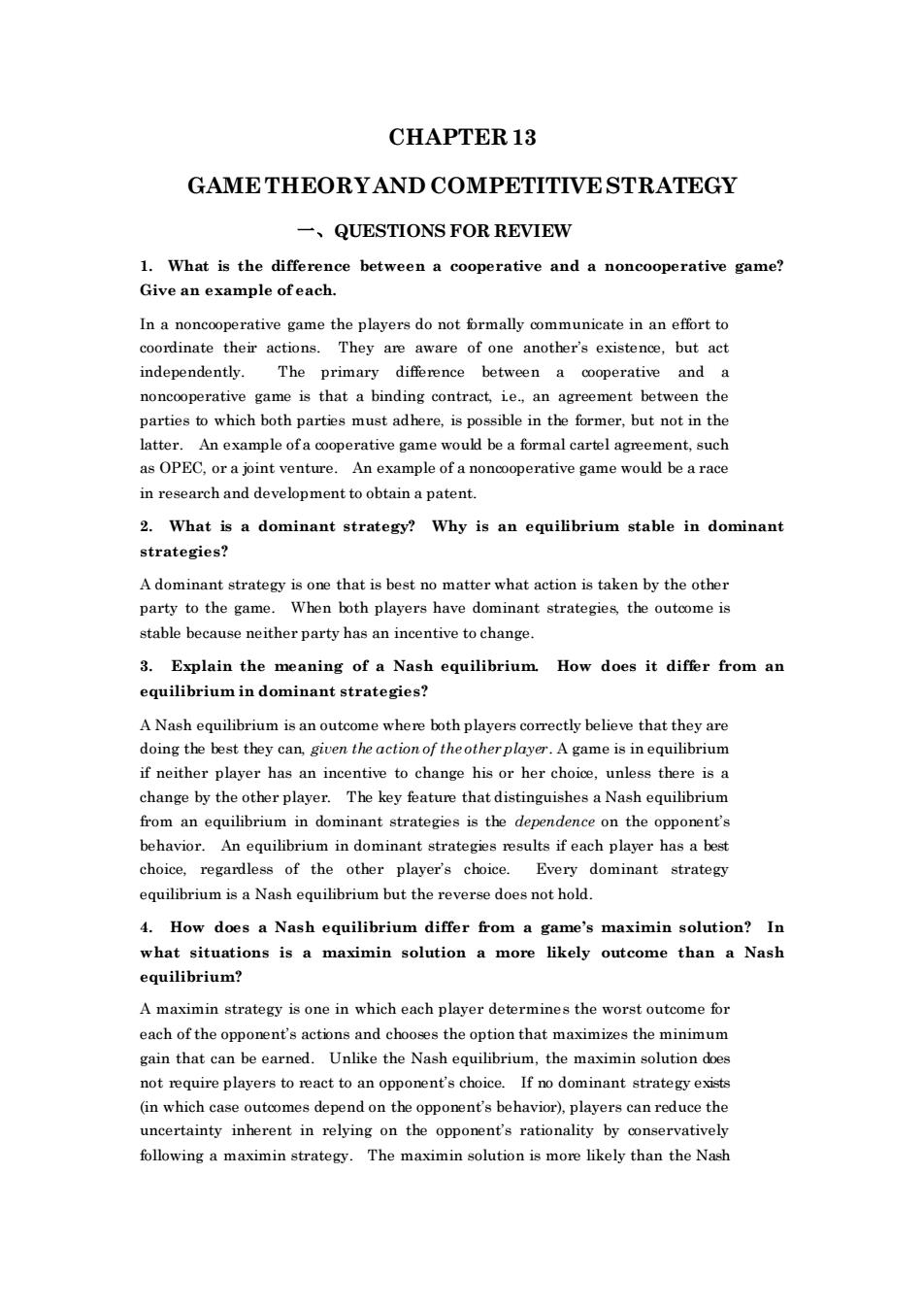正在加载图片...

CHAPTER 13 GAMETHEORYAND COMPETITIVESTRATEGY QUESTIONS FOR REVIEW 1.What is the difference between a cooperative and a noncooperative game? Give an example ofeach. In a noncooperative game the players do not formally communicate in an effort to coordinate their actions.They are aware of one another's existence,but act independently The primary noncooperative game is that a binding contract,ie.,an agreement between the parties to which both parties must adhere,is possible in the former,but not in the latter.An example ofa cooperative game would be a formal cartel agreement,such as OPEC.or a joint venture.An example of a noncooperative game would be a race in research and development to obtain a patent. 2.What is a dominant strategy?Why is an equilibrium stable in dominant strategies? A dominant strategy is one that is best no matter what action is taken by the other party to the game.When both players have dominant strategies the outcome is stable because neither party has an incentive to change. 3.Explain the meaning of a Nash equilibrium.How does it differ from an equilibrium in dominant strategies? A Nash equilibrium isan outcome where both play believe that they are doingthe can,given the action of th game is in equilibriun if neither player has an incentive to change his or her choice,unless there is a change by the other player.The key feature that distinguishes a Nash equilibrium from an equilibrium in dominant strategies is the dependence on the opponent's behavior.An equilibrium in dominant strategies results if each player has a best choice regardless of the other player's choice.Every dominant strategy but the revere does not hold. 4.How does a Nash equilibrium differ from a game's maximin solution?In what situations is a maximin solution a more likely outcome than a Nash equilibrium? A maximin strategy is one in which each player determines the worst outcome for each of the opponent's actions and chooses the option that maximizes the minimum n that be arnd.Unlke the Nash them not require players to react to an opporent's choice. If no dominant strategy exi (in which case outcomes depend on the opponent's behavior),players can reduce the uncertainty inherent in relying on the opponent's rationality by conservatively following a maximin strategy.The maximin solution is more likely than the NashCHAPTER 13 GAME THEORY AND COMPETITIVE STRATEGY 一、QUESTIONS FOR REVIEW 1. What is the difference between a cooperative and a noncooperative game? Give an example of each. In a noncooperative game the players do not formally communicate in an effort to coordinate their actions. They are aware of one another’s existence, but act independently. The primary difference between a cooperative and a noncooperative game is that a binding contract, i.e., an agreement between the parties to which both parties must adhere, is possible in the former, but not in the latter. An example of a cooperative game would be a formal cartel agreement, such as OPEC, or a joint venture. An example of a noncooperative game would be a race in research and development to obtain a patent. 2. What is a dominant strategy? Why is an equilibrium stable in dominant strategies? A dominant strategy is one that is best no matter what action is taken by the other party to the game. When both players have dominant strategies, the outcome is stable because neither party has an incentive to change. 3. Explain the meaning of a Nash equilibrium. How does it differ from an equilibrium in dominant strategies? A Nash equilibrium is an outcome where both players correctly believe that they are doing the best they can, given the action of the other player. A game is in equilibrium if neither player has an incentive to change his or her choice, unless there is a change by the other player. The key feature that distinguishes a Nash equilibrium from an equilibrium in dominant strategies is the dependence on the opponent’s behavior. An equilibrium in dominant strategies results if each player has a best choice, regardless of the other player’s choice. Every dominant strategy equilibrium is a Nash equilibrium but the reverse does not hold. 4. How does a Nash equilibrium differ from a game’s maximin solution? In what situations is a maximin solution a more likely outcome than a Nash equilibrium? A maximin strategy is one in which each player determines the worst outcome for each of the opponent’s actions and chooses the option that maximizes the minimum gain that can be earned. Unlike the Nash equilibrium, the maximin solution does not require players to react to an opponent’s choice. If no dominant strategy exists (in which case outcomes depend on the opponent’s behavior), players can reduce the uncertainty inherent in relying on the opponent’s rationality by conservatively following a maximin strategy. The maximin solution is more likely than the Nash